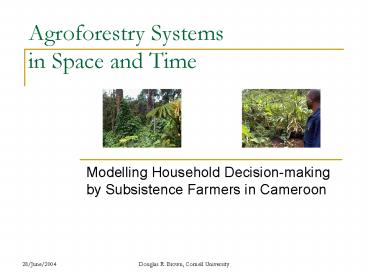Agroforestry Systems in Space and Time - PowerPoint PPT Presentation
1 / 24
Title:
Agroforestry Systems in Space and Time
Description:
Douglas R. Brown, Cornell University. Agroforestry Systems. in Space and Time ... Social Sciences and Humanities Research Council of Canada. Cornell University ... – PowerPoint PPT presentation
Number of Views:99
Avg rating:3.0/5.0
Title: Agroforestry Systems in Space and Time
1
Agroforestry Systems in Space and Time
- Modelling Household Decision-making by
Subsistence Farmers in Cameroon
2
Shifting Cultivation
- A form of semi-subsistence agriculture
- An agroforestry system
- Forest resources used for
- Agricultural production
- Non-timber forest products
- A dynamic spatial phenomenon
- Multiple patches in various locations
- Cleared for temporary cultivation
3
Shifting Cultivation
- Issues
- Sustainability of agriculture-fallow-forest
mosaic - Sustainability of household livelihoods
- Ex ante assessment of alternatives
4
Dynamics of Shifting Cultivation
Characterized by temporary forest clearing
Each patch is a dynamic system
5
Spatial Aspects of Shifting Cultivation
The choice of patches for active cultivation is a
spatial process
A dynamically evolving spatial mosaic
6
Resources for Shifting Cultivation
- Constrained by household resources
- subsistence requirements
- labour resources
7
Forest Margins Benchmark
- Population density
- Forest availability
- Market access
8
The Mixed Food Crop Field
9
Field Fallow Forest Succession
Forest melon field (1 year)
Fulu (0 years)
Primary forest (gt20 years)
Mixed food crop field(3 years)
Secondary forest (11-20 years)
Young fallow (1-4 years)
Forest fallow (5-10 years)
10
Determining the Preferred Patch
- Two components to measure
- Characteristics of patches available to household
- Importance or value of these characteristics
- Household-specific socioeconomic circumstances
- Generate patch-specific scores
- Household chooses the best patches for
cultivation in any one year
11
Preference Elicitation
- Importance of farmers decision criteria
regarding - Field location
- Field size
- Crop mixture
- Preferred type or age of fallow
- Fallow, forest-fallow forest
- Stated preferences
12
Preference Elicitation
- Relative suitability of principle types of
available land - Fallow, forest-fallow forest
- Availability of principle types of land
- Size of the households choice set
- Actual types of land chosen
- Revealed preferences
13
Survey Methodology
- Household survey
- Semi-structured interview
- Modified version of an indigenous board game
- Used in East Africa by Franzel for farmer
evaluations of AF species - Quantified importance of decision criteria
14
Field Location
Mixed food crop field, season A
15
Preferred Fallow Age Lower Limit
16
Preferred Fallow Age Upper Limit
17
Suitability of Fallow Types
18
Availability of Fallow Types
- Bounds of choice set
19
Actual Choice of Fallow
- Revealed preferences
20
Conclusions
- Factors affecting decision-making
- Economic variables
- Non-economic variables
- Preferred fallow age and suitability
- Correspond closely
21
Conclusions
- Long-term viability of shifting cultivation
- Some households lack sufficiently old fallows to
ensure maintenance of yields in the long run - Lack of resources may not constrain choices
- Individual preferences may mean that choices are
well within the bounds of the choice set
22
Some implications
- Preferences are important
- Understand preferences to understand behaviour
- Preferences dont fit our mental models well
- i.e., optimal rotation, fertility
- The decision process is much more complex
23
Some implications
- Efforts to change preferences can have a
considerable impact on household livelihoods and
the landscape - Price changes can have a real impact on outcomes
- Outcomes also depend on initial conditions
24
Acknowledgements
- Support for this research has been provided by
- International Institute of Tropical Agriculture
and the Alternatives to Slash and Burn program - Social Sciences and Humanities Research Council
of Canada - Cornell University































